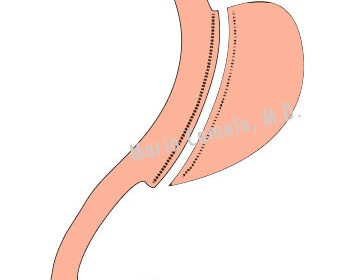
In Mexico, gastric sleeve surgery is the most-performed bariatric surgery. Gastric sleeve surgery uses the restrictive method to reduce weight, by making the stomach feel fuller faster, and by reducing the hormone Ghrelin. This, ‘two-step’ approach leads patients to higher expected weight loss, than Lap-Band (gastric banding surgery) with minimal complications or risks.
How Gastric Sleeve Works
Gastric sleeve, also known as the sleeve gastrectomy, is a weight loss surgical procedure that is done in order to remove the size of a patient’s stomach. Typically the stomach is reduced to about 25% of its original size. The surgery itself is not a reversible surgery since the larger portion of the stomach is removed entirely as opposed to other bariatric surgeries such as gastric bypass, which can be reversed. While this surgery cannot be reversed, it can be performed laparoscopically, which minimizes the time it takes to recovery after the procedure.
Statistics and Results of Gastric Sleeve
Countless studies have been done in order to showcase the results and rates of the gastric sleeve surgery itself. These studies have been performed to depict both short-term and long-term success rates following gastric sleeve surgery. They look at how much weight was lost as well as how long this weight was kept off for. Some statistics to keep in mind with short-term studies include patients who have lost up to 60% of their excess body weight in just one year following surgery, 70% of excess body weight loss in the first two years and the resolution of many comorbidities such as high blood pressure, Type II Diabetes, cholesterol and sleep apnea 1-2 years following sleeve gastrectomy.
One Swiss study shows that on average patients have lost more than 57 percents of their excess body weight after five years of having a gastric sleeve procedure. It’s important to note that some patients get a duodenal switch procedure done following their gastric sleeve surgery. This particular study showed that most of the weight lost did occur in the first year following surgery and the rest of the weight did come off slowly for the following four years. In terms of long-term success rate, there was a continued reduction of comorbidity rates. The New England Journal of Medicine reports that gastric sleeve surgery resulted in 23-40% reduction of premature mortality because of obesity or comorbidity related to a patient’s weight. It’s important to note that results do vary from patient to patient.
Typically gastric sleeve is one of the first recommended surgical procedures for patients with a body mass index of over 50. While gastric sleeve surgery isn’t the only viable weight loss option, it does have its successes. There are a few drawbacks that some patients mention when asked of their satisfaction with the procedure. These include that the stomach size reduction is permanent, the fact the surgery isn’t reversible and the need for duodenal switch surgery for many patients after recovery occurs. Ultimately gastric sleeve has many proven successes and most patients see adequate weight loss for a minimally-invasive procedure.